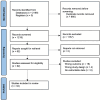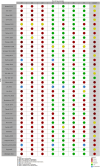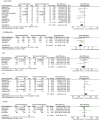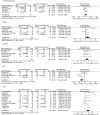Predictors of successful weaning from veno-arterial extracorporeal membrane oxygenation (V-A ECMO): A systematic review and meta-analysis
- PMID: 40106427
- PMCID: PMC11922212
- DOI: 10.1371/journal.pone.0310289
Predictors of successful weaning from veno-arterial extracorporeal membrane oxygenation (V-A ECMO): A systematic review and meta-analysis
Abstract
Background: Venoarterial extracorporeal membrane oxygenation (V-A ECMO) use to support patients in cardiac failure is increasing. Despite this increased use, predicting successful weaning from ECMO can be challenging, no uniform guidelines on weaning exist. Therefore, we completed a systematic review to evaluate prognostic factors that predict successful weaning from V-A ECMO.
Methods: Following the PRIMSA guidelines, a systematic literature search of Medline, Embase, SCOPUS and CENTRAL identified original research studies of patients requiring V-A ECMO where weaning was attempted. Data was collected on demographic factors and weaning protocol, biomarkers, haemodynamic, echocardiographic factors for the successfully weaned (SW) and not successfully weaned (NSW) groups. Two investigators reviewed studies for relevance, extracted data, and assessed risk of bias using the ROBINS-I tool. The study was registered on the international prospective register of systematic reviews (PROSPERO ID# CRD42022366153).
Results: 1219 records were screened, of which 20 studies were deemed sufficient to be included in the statistical analysis based on pre-specified criteria. Factors associated with successful weaning were higher left ventricular ejection fraction (LVEF) (MD 9.0, 95% CI 4.1-13.8; p < 0.001) and left ventricular outflow tract velocity time integral (LVOT VTI) at time of weaning, (MD 1.35, 95% CI 0.28-2.40 lactate at admission (MD -3.2, 95% CI -4.8 to -1.5, p < 0.001), and CK-MB at admission (MD -4.11, 95%CI -6.6 to -1.6, p = 0.001). Critical appraisal demonstrated moderate-high risk of bias owing to confounding and low sample sizes.
Conclusion: In patients on V-A ECMO support being assessed for weaning multi-parametric assessment is required. Moderate-high heterogeneity and low sample sizes warrant higher-quality studies to help guide decisions to wean patients from V-A ECMO.
Copyright: © 2025 Hsu et al. This is an open access article distributed under the terms of the Creative Commons Attribution License, which permits unrestricted use, distribution, and reproduction in any medium, provided the original author and source are credited.
Conflict of interest statement
The authors have declared that no competing interests exist.
Figures





Similar articles
-
Parameters associated with successful weaning of veno-arterial extracorporeal membrane oxygenation: a systematic review.Crit Care. 2022 Dec 5;26(1):375. doi: 10.1186/s13054-022-04249-w. Crit Care. 2022. PMID: 36471408 Free PMC article.
-
[Effect evaluation of bedside ultrasound monitoring of left ventricular functional parameters combined with clinical indicators on veno-arterial extracorporeal membrane oxygenation].Zhonghua Wei Zhong Bing Ji Jiu Yi Xue. 2021 Mar;33(3):329-333. doi: 10.3760/cma.j.cn121430-20201023-00684. Zhonghua Wei Zhong Bing Ji Jiu Yi Xue. 2021. PMID: 33834975 Chinese.
-
Hemodynamic and Echocardiographic Predictors of Mortality in Pediatric Patients on Venoarterial Extracorporeal Membrane Oxygenation: A Multicenter Investigation.J Am Soc Echocardiogr. 2023 Feb;36(2):233-241. doi: 10.1016/j.echo.2022.10.005. Epub 2022 Oct 10. J Am Soc Echocardiogr. 2023. PMID: 36228840
-
A systematic approach to weaning from extracorporeal membrane oxygenation in patients with refractory cardiac failure.Acta Anaesthesiol Scand. 2021 Aug;65(7):936-943. doi: 10.1111/aas.13814. Epub 2021 Mar 27. Acta Anaesthesiol Scand. 2021. PMID: 33728635
-
Understanding the "extracorporeal membrane oxygenation gap" in veno-arterial configuration for adult patients: Timing and causes of death.Artif Organs. 2021 Oct;45(10):1155-1167. doi: 10.1111/aor.14006. Epub 2021 Jul 6. Artif Organs. 2021. PMID: 34101843 Free PMC article.
References
Publication types
MeSH terms
LinkOut - more resources
Full Text Sources
Medical
Research Materials
Miscellaneous

